Icy Inverts Cruise 2013 - Shipboard Blog - Nov 30th to Dec 03rd
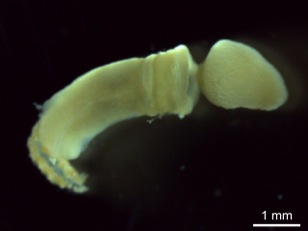
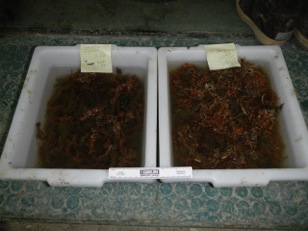
03 Dec 2013 - Erebus and Terror Bay (63o 57`S, 56o 33`W)
We are in Antarctica to study various aspects of the biology of marine invertebrates. Even if you aren’t a biologist, you are probably more than familiar with lots of different types of animals without backbones… sea stars, sea anemones, shrimp, octopus, sponges, etc. I feel like I may sound like some sort of invertebrate zoology hipster when I say this, but you probably haven’t heard of the group I study, aplacophoran molluscs (they’re way cool and you should totally look them up). Instead of talking all about them, today I’m going to write about a couple of other groups unusual organisms we’ve collected during this trip that you might not be familiar with.
This first group I’m going to talk about is a shout out to Halanych lab member Dr. Joie Cannon who participated in the December 2013 – January 2013 cruise (Hi Joie! Wish you were here!). Joie is an expert on a group of a marine invertebrates called Hemichordata. Hemichordates come in two flavors, acorn worms (Enteropneusta, see above left image) and pterobranchs. One of the (many) reasons this group is interesting is because they are actually relatively closely related to Chordata (our own phylum). Acorn worms are solitary worms that live on burrow in the sea bottom. They are relatively common animals and can be found worldwide if you know where to look. Pterobranchs on the other hand are much rarer. However, Antarctica happens to be a hotspot for pterobranch diversity. Unlike acorn worms, pterobranchs are actually colonial animals that secrete a complex tube system called a coenecium and reproduce asexually by budding off other individuals. Although they are very different, these two groups of animals are clearly related. Both have a body with three parts: a proboscis, collar (bears the tentacles in pterobranchs), and trunk (includes the stolon that connects the individuals in a pterobranch colonly to each other). During our last trawl (which included incredible diversity!), we recovered TONS of colonies of two species of pterobranchs representing two species (see above right image). Under the microscope, you can see two zooids of Cephalodiscus at different stages of development (see below left image). Unlike acorn worms, which are deposit feeders, pterobranchs use their tentacular arms to collect food from the water column.
The other unusual animal we collected is called a myzostomid (see below right image). Myzostomids are unusual parasites that usually live on or in echinoderms (sea stars, feather stars, brittle stars, etc.). They have also been something of an evolutionary enigma. Some researchers have thought that myzostomids are derived segmented worms (Annelida) as they share certain morphological features with most annelids. Others have argued that they are a separate lineage, possibly related to flatworms. Recent molecular data has pretty clearly shown that myzostomids are annelids but they have a high rate of evolution leading to really unusual DNA sequences (a phenomenon common in parasites) that makes it difficult to say exactly which annelids myzostomids are most closely related to. We have collected a few different species of myzostomids including this specimen that was found on the sea lily Anthometra. This specimen was preserved for transcriptome or possibly even genome sequencing so that it could potentially be used sometime down the road to help address this question.
Contributed by: Dr. Kevin Kocot, Postdoctoral Fellow, Auburn University
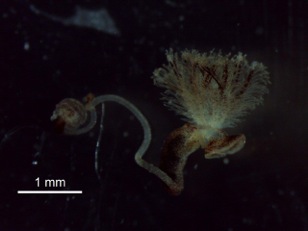
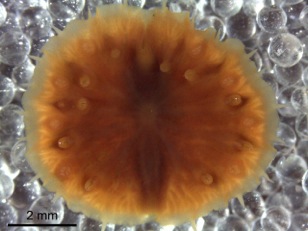
***************************************************************************************
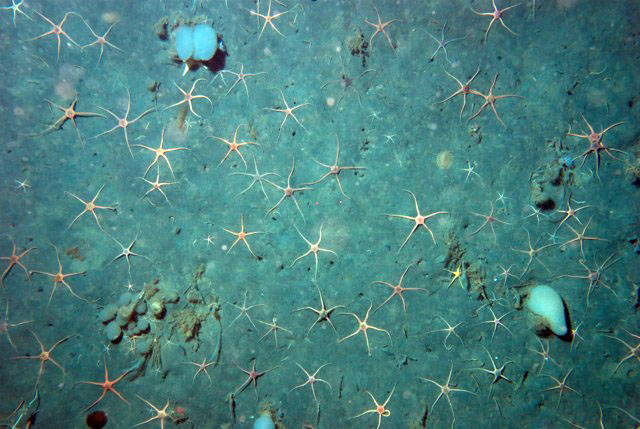
02 Dec 2013 - Vega Island (63o 44`S 57o 23`W)
Working in the Weddell is a lot of fun. On this, my sixth cruise to Antarctica, I am still in awe of the new discoveries and how much there is to learn about this fabulous ecosystem. Let me correct that – ecosytemS. It seems every time we look at the bottom with the Yo-Yo cam or sample it with the Blake trawl, we find a completely different ecosystem. We find new and different animals, like the new-to-science 8-inch marine leech found last night, but the composition of animals in the community has also varied widely from place to place. One of the first stations in the Weddell was characterized by brittle stars. You have heard a little from David Branson about the Yo-Yo camera. This Yo-Yo cam picture (see above image) shows the bottom covered by brittle stars – literally a blanket on the bottom made up of a few species of these understudied echinoderm. When I first saw these pictures, I was struck by the shear numbers of brittle stars 300 meters below the surface. However, there is MUCH more information conveyed in these pictures. Notice how the brittle stars are positioned relative to each other? They only touch at the tips of their arms; they don’t really overlap. Why do they do that? I don’t know! But these animals seem to have a way to communicate and space themselves. Not bad for animals with no centralized brain!
The next site was covered in tunicates. Tunicates are sessile animals that filter feed for a living, and they are the closest invertebrate relatives to you and me! They can either be solitary or colonial in nature…..we got lots of both! What was amazing about these tunicates was their size. The animals are the shape of a fat club and up to a foot long. The bottom was covered with these, providing three-dimensional structure. This provided protection and more habitat for additional animals, resulting in an overall increase in diversity. For us, that means we recovered lots of crustaceans, sea-spiders, and other animals in this 3D environment. What this also tells us is that some of the same “ecological rules” apply in the Antarctic as in other oceanic regions. For examples, the 3D nature of corals reefs provides structure and increase biodiversity, and the reason fishermen look for structure in any environment is because that is were the fish hide.
In comparison to those two environments, last night we sampled a more shallow, 180 meters deep, area next to James Ross Island, named after a famous British Antarctic explorer. This site was covered with tiny little bivalve mollusk and also hosted high numbers of a sea star we have been looking for, Odontaster validus. The reason that these different environments all have different species compositions is a mystery, but we have some ideas of the factors that may influence the ecosystem dynamics. Physical characteristics such as amount of current, depth and proximity to terrestrial environments (because of runoff) may be important factors. Also the amount of energy these environments receive may be vastly different depending on which food sources reach the seafloor from the overlying water column.
One thing we have noticed about the Weddell is that the water is markedly colder and that the entire water column is mixed. You know how when you swim in a lake or pond in the summer time and the upper water is warmer than the deeper water? Well that happens in marine systems as well, but currently in the Weddell the water column is a fairly uniform -1.5-1.70C. Seawater freezes at about -1.8oC. Needless to say, this means we often have painfully cold fingers while working with the samples for hours (see below image)! While this is a pain, we are willing to endure it because of the exciting, wonderful and spectacular organisms we are finding in this coldest part of the planet.
Contributed by: Dr. Ken Halanych, Chief Scientist, Schneller Endowed Chair, Auburn University
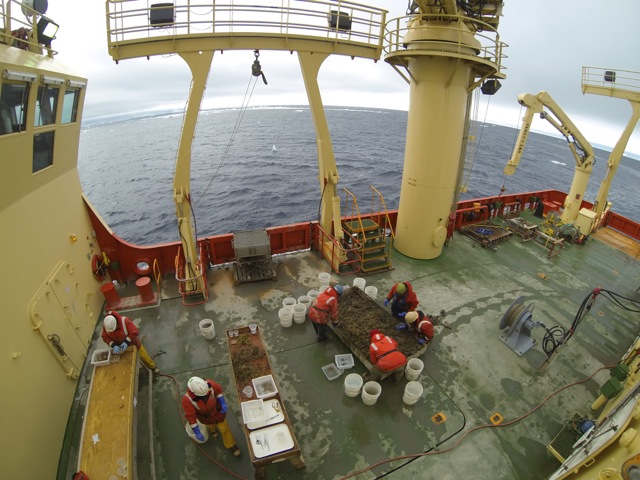
***************************************************************************************
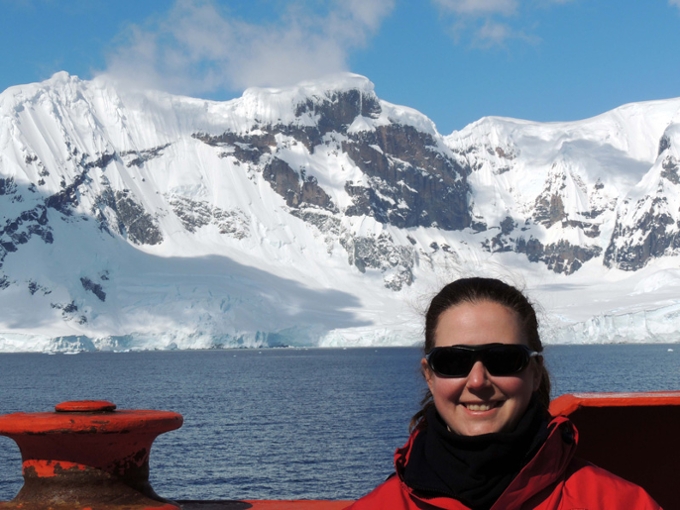
01 Dec 2013 – All the small things… (64˚01`S 56˚44`W)
Never in my wildest dreams did I ever think I would have the opportunity to travel to Antarctica, let alone twice in one year (see above image). The second Icy Inverts Research Expedition to Antarctica in 2013 has been amazing thus far. We are traveling to different geographic locations within Antarctica than we did last expedition and are already noticing differences in the organisms we are seeing. For example, last night the benthic trawl revealed much larger brittle stars and tunicates than we have seen before. The diversity of the marine benthic organisms is just amazing! I love how every location we sample is different from the last.
My research interest on this cruise focuses on meiofauna, which are the small marine invertebrates that live between sediment grains. These organisms play important key roles in ecosystem functioning; however, little is known about the composition of these communities, especially in Antarctica. I have been able to collect sediment samples (using a box core, see below image) on both the current and previous expeditions in order to examine the meiofaunal community composition as well as explore the variation of these communities between water basins. My sampling method consists of collecting both the top 0-2cm and 2-5cm fractions of mud cores, which I immediately freeze at -80˚C. Upon returning to Auburn University, I extract environmental DNA (DNA from all organisms present in the sample) from the sediment. With the aid of next generation sequencing and bioinformatics tools, I am able to classify taxa that are present in the sample and well as examine the proportion of the community each taxa represents; therefore, comparisons of community composition between sampled locations can be made.
Well we are at another sampling station so it is time to get geared up to go outside and start collecting again. I am extremely excited to see what we may find at this location!
Submitted by: Dr. Pamela Brannock, Postdoctoral Fellow, Auburn University
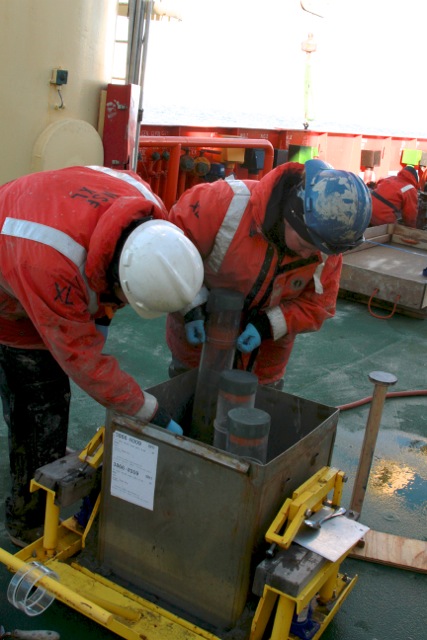
***************************************************************************************
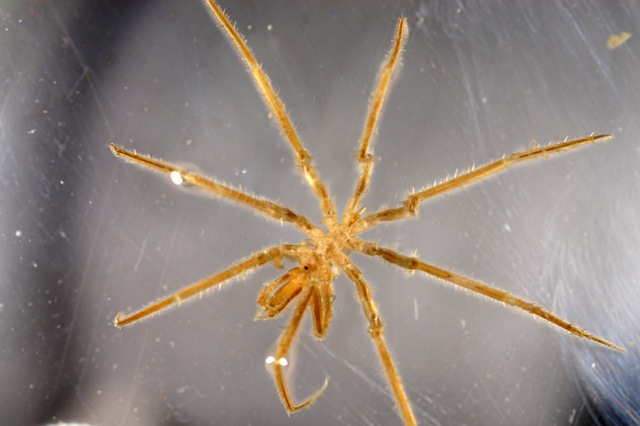
30 Nov 2013 – In the Weddell Sea (64o 19S’ 56o 06W’)
What an experience for me, a terrestrial ecophysiologist who has focused mostly on desert insects, to be on an Antarctic expedition led by the Auburn and CMU groups studying biodiversity, evolutionary relationships and phylogeography in all manner of marine invertebrates. I’m here studying sea spiders (Pycnogonida) and asking several of my long standing questions: How has the cellular stress response evolved in organisms inhabiting extreme environments? What is the relationship of body size to gas exchange and microanatomical properties of the exoskeleton in arthropods? I did bring some video equipment and, to address my biomechanical interests, plan on making some movies of sea spider locomotion in order to investigate gait characteristics of sea spiders versus terrestrial chelicerates.
In our first trawl we brought up hundreds of animals, most no bigger than a pinky finger, and all encased in roughly a ton of sea-floor mud. After several hours of rinsing, sifting and sorting, I had several specimens of the sea spider Nymphon australe (see above image) for initial pictures and observations (first important - and critical - observation: they seem to tolerate a brief encasement in mud reasonably well!). In the trawls we’ve also had starfish, polychete worms, sea cucumbers, bivalves and cnidarians, including a large jellyfish (translucent pink and about 0.5m in diameter). There have been fist-sized octopus that look little like the ones I’ve seen in tropical and temperate waters. Here, their arms are extremely short compared to their overall body size, and they look cartoonish. We’ve also pulled up ice fish from the family Channichthyidae, creatures I’ve long read about for their evolutionary loss of the oxygen-binding pigment hemoglobin, which isn’t needed for a fish whose body temperature is never above 0 C. Plasma-dissolved oxygen satisfies all the needs of its slow aerobic metabolism. I’m relying on my colleagues to help me identify the myriad of invertebrates that we’re seeing. So many different little worm-like creatures – I dread the inevitable moment when someone corrects me with “Wrong phylum, Steve!”.
The scenery has been breathtaking (see below image). Everything you have heard about the beauty of Antarctic landscapes, seascapes and wildlife is true. After the last night of a rough-for-me-but-tame-for-seafarers crossing of the Drake Passage lasting three days, I awoke to incredible vistas of sea, ice and mountains. I can count on one hand the number of places in which I’ve seen such natural beauty: Alaska, the Sonoran Desert, Iceland, the Sea of Cortez, and the Galapagos Islands. During the crossing we saw many seabirds (shags, albatrosses, petrels, skuas, gulls, terns, shearwaters), fur seals and dolphins. In the Antarctic coastal waters we’ve seen Adelie, gentoo and chinstrap penguins, crab-eater and leopard seals and minke whales.
My colleague and roommate Christoff Held made a profound observation at one of our science team meetings. He said that the tourists aboard the Antarctic cruise ships deserve some pity because they are actually missing Antarctica’s greatest wildlife show, and that is the spectacular array of marine invertebrate species, numbering in the hundreds (or thousands?) and with extensive endemism. From what I’ve seen just our first samples, Christoff is absolutely correct. If I ran a cruise ship there would be trawl nets and yo-yo cameras.
A final comment on logistical support, the level and quality of which determines whether scientific expeditions succeed or fail. The details involving getting a bunch of scientists to Antarctica so that they can collect and study marine organisms are mind-numbing in terms of volume and complexity. The National Science Foundation, US Antarctic Program and especially the crew of the RV Laurence M. Gould have been exemplary in their support of this expedition.
Contributed by: Dr. Stephen Roberts, Central Michigan University
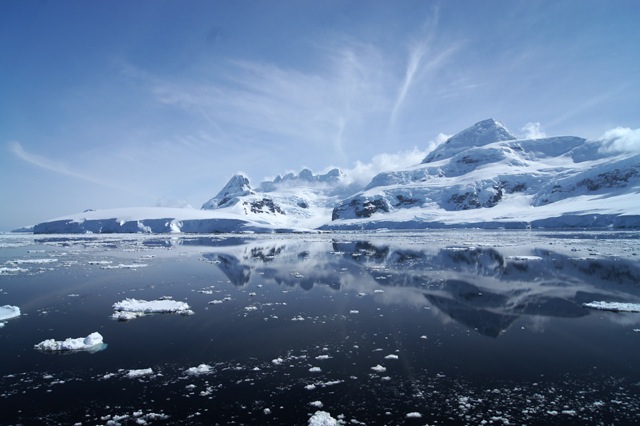
Last updated: 12/03/2013
